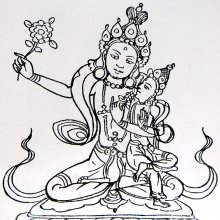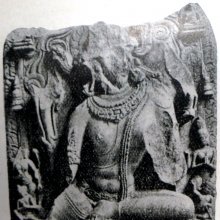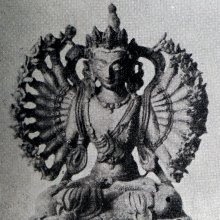Sarasvatisthana, Sarasvatīsthāna, Sarasvati-sthana: 2 definitions
Introduction:
Sarasvatisthana means something in Buddhism, Pali, the history of ancient India. If you want to know the exact meaning, history, etymology or English translation of this term then check out the descriptions on this page. Add your comment or reference to a book if you want to contribute to this summary article.
Images (photo gallery)
In Buddhism
Tibetan Buddhism (Vajrayana or tantric Buddhism)
Source: archive.org: The Indian Buddhist IconographySarasvatīsthāna (सरस्वतीस्थान) correspond to the ancient Mañjuśrī Hill, close the Svayambhūkṣetra (“place of the Self-Born”) in Nepal, whose glories are dealt with in the Svayambhūpurāṇa.—The Ādibuddha manifested himself here in the shape of a flame of fire, and so it is called the Svayambhūkṣetra (“place of the Self-Born”). This place is consecrated with a temple of Ādibuddha, and close to it is the Mañjuśrī Hill now known as the Sarasvatīsthāna.

Tibetan Buddhism includes schools such as Nyingma, Kadampa, Kagyu and Gelug. Their primary canon of literature is divided in two broad categories: The Kangyur, which consists of Buddha’s words, and the Tengyur, which includes commentaries from various sources. Esotericism and tantra techniques (vajrayāna) are collected indepently.
India history and geography
Source: What is India: Inscriptions of the ParamarasSarasvatīsthāna (सरस्वतीस्थान) is the name of a village mentioned in the “Māndhātā copper-plate inscription of Devapāla”.—Sarasvatīsthāna suggests its identification with the ancient Sarasvatī-pattana, the same as the modern Surwāyā in the Shivpurī District of Madhya Pradesh.
These copper plates (mentioning Sarasvatīsthāna) were discovered in 1905 in the former State of Dhār, near the temple of Siddheśvara at Māndhātā, better known by the longer name Oṃkāra-Māndhātā (an island in the Narmadā attached to the East Nemāḍ District in Madhya Pradesh). It records the donation of the village of Satājunā in the Mahuaḍa Pratijāgaraṇaka, by Devapāla. It is dated on the full moon day of Bhādrapada in the (Vikrama) year 1282, which corresponds to the 19th August, 1225 A.C.

The history of India traces the identification of countries, villages, towns and other regions of India, as well as mythology, zoology, royal dynasties, rulers, tribes, local festivities and traditions and regional languages. Ancient India enjoyed religious freedom and encourages the path of Dharma, a concept common to Buddhism, Hinduism, and Jainism.
See also (Relevant definitions)
Partial matches: Sthana, Sarasvati.
Full-text: Svayambhukshetra.
Relevant text
Search found 1 books and stories containing Sarasvatisthana, Sarasvatīsthāna, Sarasvati-sthana, Sarasvatī-sthāna; (plurals include: Sarasvatisthanas, Sarasvatīsthānas, sthanas, sthānas). You can also click to the full overview containing English textual excerpts. Below are direct links for the most relevant articles:
The Indian Buddhist Iconography (by Benoytosh Bhattachacharyya)



